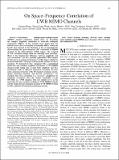On Space–Frequency Correlation of UWB MIMO Channels
Author(s)
Hong, Xuemin; Wang, Cheng-Xiang; Thompson, John; Allen, Ben; Ge, Xiaohu; Malik, Wasim Qamar; ... Show more Show less
DownloadHong-2010-On Space-Frequency C.pdf (1.159Mb)
PUBLISHER_POLICY
Publisher Policy
Article is made available in accordance with the publisher's policy and may be subject to US copyright law. Please refer to the publisher's site for terms of use.
Terms of use
Metadata
Show full item recordAbstract
Conventional multiple-input-multiple-output (MIMO) channel correlation models focus on describing the complex amplitude correlation of resolvable multipath components (MPCs). It has recently been shown that the time-of-arrival (ToA) correlation of resolvable MPCs, which has largely been ignored in the literature so far, is important for characterizing the space-frequency (SF) correlation of MIMO channels in the ultrawideband (UWB) regime. The proposal of ToA correlation brings forth the following open questions: What is the fundamental difference between amplitude and ToA correlations? Are they mutually replaceable? What impact do they have on system performance? Is this impact related to channel bandwidth? This paper systematically answers the above questions. We demonstrate that, compared with a conventional model that only considers amplitude correlation, a UWB MIMO channel model taking into account both amplitude and ToA correlations leads to different theoretical maximum diversity order, numerical structure of the SF channel covariance matrix, spatial correlation function, and diversity performance. We conclude that ToA correlation is a necessary complement to amplitude correlation when the channel bandwidth exceeds 500 MHz, i.e., UWB channels. This new insight serves as the motivation for more realistic modeling of UWB MIMO channels and the inspiration for designing advanced UWB MIMO systems to fully exploit the SF channel correlation properties.
Date issued
2010-11Department
Massachusetts Institute of Technology. Department of Brain and Cognitive SciencesJournal
IEEE Transactions on Vehicular Technology
Publisher
Institute of Electrical and Electronics Engineers (IEEE)
Citation
Hong, Xuemin et al. “On Space–Frequency Correlation of UWB MIMO Channels.” IEEE Transactions on Vehicular Technology 59.9 (2010): 4201-4213. Web. 3 Feb. 2012. © 2011 Institute of Electrical and Electronics Engineers
Version: Final published version
Other identifiers
INSPEC Accession Number: 11630027
ISSN
0018-9545
1939-9359